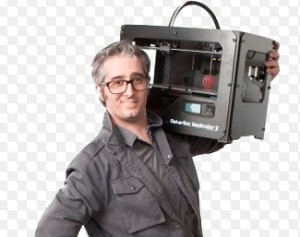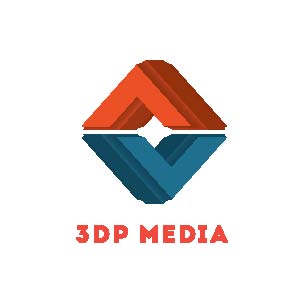The Downtown Brooklyn Partnership Provided A Platform—TED Talk-Like—For Five Community Leaders To Present Their Visions Of The Brooklyn Future For Ten Minutes Each: We—Naturally—Focus Here On MakerBot’s CEO, An Innovator Known For Thinking (Way) Outside The (3D-Printer) Box: Bre Did NOT Disappoint…

Bre Pettis, Cofounder & CEO of MakerBot, with Replicator 2 desktop printer, on the way to thinking outside the (3D-Printer) box—as usual…
Tucker Reed, President of the Downtown Brooklyn Partnership (DBP), debuted the first of his organization’s “5×10 Talks” to a full-house crowd at the newly made-over BRIC Arts|Media House on Fulton Street in Downtown Brooklyn on the evening of 6 May 2014. (BRIC was once an acronym for “Brooklyn Information & Culture”; it’s mandate is now much broader and its acronym is a slightly mysterious brand.)
Tucker characterized this iteration of his new public platform as intended to “showcase all the innovation that is happening in Downtown Brooklyn.”
Further, President Reed went on to say, “Vision — and the grit to realize it — is NOT new to this neighborhood…this ethos has been infusing this corner of the world for much longer than any of us have had the pleasure to be here.” This evening, we’re going to “hear from a number of our generation’s innovators that call this neighborhood home…and speak on the topic: ‘What’s next?!’”
The “5×10 Talks”—broadly interpreted as it turned out—was an eclectic mix of entertainment, profiles, prognostications and even an award presentation. You got more than your money’s worth…
Bre Pettis—known as a crowd-pleasing speaker who is at the helm of one of Brooklyn’s hottest and most innovative startups—closed out the show with his 5×10 Talk. And, curiously enough, Bre was the only speaker among the “5″ who actually addressed the premise of the evening: “What’s next?”—full on.
Mr. Pettis started his presentation with the unabashed “…[at MakerBot] we’re kicking ass…MakerBot’s secret ingredient is Brooklyn pride…it’s very powerful!” Of course, the audience—a VERY partisan Brooklyn group—went wild!
Bre continued, “So, when I thought about what’s going to happen next…everyone else has been telling you what they are doing. I’m going to figure out what IS going to happen next…” Consider these ideas as “…maybe some hints about what is coming…if I were starting [MakerBot] over again now, these are the things I would wiggle my way into and see if there is something there…”
MakerBot CEO Pettis divided his “next things” into five categories and a summation:
Automation
In past public forums, Bre has commented on the “tipping-point” concept of automation begetting automation. Or, the robot builds itself—as an endless, geometrically accelerating propagation mode. In this talk, he summed up the idea by saying that at MakerBot we are now “…using MakerBots to make MakerBots.” He illustrated this idea with a slide of a MakerBot production line tooled with fixtures built by MakerBots.
Mr. Pettis segued to his next point by leveraging off automation to empowerment. We’ve “made a thing that let’s other people to make things, create things, that will allow other people to be creative—[it] is a VERY powerful force…”
Customization
Bre stated that he has dedicated his life to “…empowering creative people,” in fact “we actually empower people to be creative for other people…it’s getting pretty meta…”
He continued: “[We are] entering a super-empowered world—where you’re not limited by what is available. You can be a creative, and — if other people like it — you can have a business before you know it…”
We’re now in a universe of “DIY choice” driving infinite—and potentially commercializable—customization.
Individual Sharing
This title—for a little more clarity—might have read “Individuals Sharing With Individuals Via Online Groups.”
Here’s how Bre illustrated this idea: “I want to learn to use a chainsaw.” [This, just after he had told us a story about taking time off to go build a customized muscle-car in the Arizona desert.] Until the last few years, this [chainsaw passion] would have been a difficult proposition. “What’s cool [now] is…there is a whole group at ChainsawScuptors.com—with 838 members—working together, creating instructions and empowering anyone to use a chainsaw. I don’t need to go to chainsaw school!”
Until the last five years or so, you “had to rely on [educational] infrastructure and gate-keepers…at this point, if you actually want to do something…you can actually figure it out and source the resources you need [online] to figure it out and learn anything…”
Community Empowerment
CEO Pettis linked to this topic with “now anyone can do anything!” This exuberant license is no longer a fairytale you use to compel your children to excel. If your epic-win goal is susceptible to education, then that know-how and how-to is online. You’ll find this hyper-specialized, even arcane, knowledge is being shared—generally for free—on the Web. Some affiliation group—with members all over the world—have used the reach and connectivity of the Internet to coalesce people around THEIR core interest.
“If there is a whole community for just turbocharging Volvos [and there is]… There’s a community for anything! Anything!!”
“In the old world, to justify making a product, you needed at least 10,000 people interested to buy your product before you could justify making it [commercially.]”
Now, the would-be entrepreneur “doesn’t have to make 10,000 people happy. He just has to make himself happy…” This individual choice, paradoxically, drives Community Empowerment. This empowerment comes about as previously undiscoverable common passions—and their aggregation—are aligned and integrated. The Internet enables this new “community”—and its care and feeding—and grants it power.
Real-Life Communities
Bre holds that “real life” is where the action must be. To make things really happen, we all need to be “in real life, away from the keyboard.”
“Actually, if you want to build a community, you really have to eat with people. One of the secrets of actually making any project work is [eating together]. You can measure a good project by how many pizzas were involved.”
What’s Next?
Bre Pettis illustrated his 5×10 Talk with several examples of—apparently—non-MakerBot-related activities. All of them DIY and/or DIT (Do-It-Together) and most of them by-hand. I.e., muscle-car construction, Volvo care and up-grading, chainsaw apprenticeship and Japanese “Dragon Kiln” construction and use.
I kept thinking that successfully managing a hyper-growth tech company surely couldn’t provide the “mindwidth”—or personal time—to enable such “extraneous” executive interests for the “Chief Entrepreneurial Officer.”
Then, Mr. Pettis concluded his “talk” with the integration—as I suddenly saw it—of the disparate ideas he had been presenting. And, then I grasped why the incongruous suddenly seemed like the basis for creative genius. Think consilience—one of the English language’s most beautiful words…and concepts. Here’s Bre Pettis’ peroration:
“This idea of unleashing passion and obsession and having the infrastructure to indulge in this wonderful and absurd and potentially beautiful-results kinds of things…were just on the verge of something so special in the history of everything.
“When I thing about what’s next, I think about what each of you are going to unleash in your lifetimes: especially the absurd; things that might seem stupid; things that are just wonderful—and adding fire [as in a Dragon Kiln] to that…and seeing what happens when it keeps going…I’ll leave you with that…
“This is NOT the kind of talk you expected from a guy who makes 3D printers.”
C’mon Back!
LAND

 NYC3DPLand Tweets
NYC3DPLand Tweets